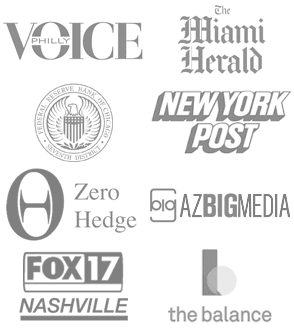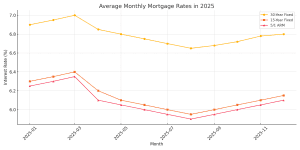Refinance mortgage rates in December 2025 remain elevated compared to the ultra-low levels during the Pandemic but they have eased off their late-2023 peaks. Homeowners looking to secure a mortgage refinance can expect average rates slightly below 6.5% for a 30-year fixed and about 6% for a 15-year fixed mortgage. Adjustable-rate refinance loans offer slightly lower initial rates – roughly 6.3% for a 5/1 ARM and around 6.0% for a 3/1 ARM on average – reflecting their shorter fixed period and added risk of future adjustments.
Shop and Compare the Today’s Best Mortgage Refinance Rates Online
Below we provide a detailed overview of current national averages, a comparison of top lenders with the lowest and best refinance mortgage rates today, and examples of monthly payments at these interest rates.
The RefiGuide also offers expert guidance on how to choose the best refinance option for your financial goals.
Take advantage of our rates guide that provides a sis by side analysis for the top banks and lenders competing for the best refinance mortgage rates in 2026.
Current National Average Refinance Mortgage Rates (December 2025)
As of December, 2025 2025, national average refinance interest rates (APR may be slightly higher) are approximately as follows:
-
30-Year Fixed Refinance: ~6.6% average interest rate (about 6.78% APR). The 30-year fixed rate mortgage is the most common refinance loan term, and rates hover around the high-6% range.
-
15-Year Fixed Refinance: ~6.05% average interest rate (roughly 6.25% APR). Shorter-term loans, like the 15-year mortgage carry lower interest rates than 30-year loans, reflecting the reduced risk to lenders.
-
5/1 ARM Refinance: ~5.94% average initial interest rate for a 5-year adjustable-rate mortgage. This hybrid ARM has a fixed rate for five years, then adjusts annually. Initial rates are comparable to 15-year fixed rates.
-
3/1 ARM Refinance: ~5.8% average initial interest rate (estimate). A 3-year ARM (fixed for three years, then annual adjust) typically offers an even lower intro rate – recent averages for 3/1 ARMs have been in the mid-5% range for purchases, so refinance rates are around 5.625–6.0% initially.
It’s worth noting that refinance rates are often slightly higher than purchase mortgage rates. Actual quotes vary based on your credit score, loan-to-value ratio, loan amount, and region. Still, these averages give a sense of the market. For example, on November 12 2025, Bankrate reported a 30-year fixed refi APR of 6.78% and 15-year fixed refi APR of 6.125% nationally. Meanwhile, Money.com’s daily survey showed similar levels. ARM refinance rates tend to be a bit lower initially – Bankrate noted a 5/1 ARM refinance rate of about 6.24% at that time.
Top 10 Lenders Offering the Best Refinance Rates Today
Many banks and mortgage companies are advertising competitive refinance rates in 2026. Below is a comparison table of 10 leading lenders known for some of the lowest refinance mortgage rates available today (for top-tier borrowers). These rates are as of December, 2025 and assume a conventional refinance; actual APRs may include points or fees. (Lenders marked N/A for certain ARM products may not widely offer that loan type.)
| Lender | 30-Year Fixed Refi | 15-Year Fixed Refi | 5/1 ARM Refi | 3/1 ARM Refi |
|---|---|---|---|---|
| Chase | 6.46% (as low as APR) | 5.92% (as low as APR) | 6.44% (as low as APR) | N/A (not typical) |
| Bank of America | 7.125% (rate) | 6.000% (rate) | 7.125% (rate) | N/A (not offered) |
| LoanDepot | 6.575% (rate) | 5.75% (rate) | ~6.25% (est.) | N/A |
| Guaranteed Rate (Rate.com) | 6.796% (rate) | 6.103% (rate) | ~6.4% (est.) | N/A |
| Rocket Mortgage (Quicken) | ~7.00% (avg) | ~6.30% (avg) | ~6.5% (avg) | N/A |
| SoFi | ~6.70% (est.) | ~6.10% (est.) | ~6.3% (est.) | N/A |
| Navy Federal CU | 6.25% (as low as rate) | 5.50% (as low as rate) | 5.75% (initial rate) | 5.50% (initial rate) |
| PenFed Credit Union | 6.625% (as low as rate) | ~6.00% (est.) | ~6.25% (est.) | ~6.00% (est.) |
| Citizens Bank | 7.00% (rate) | 6.25% (rate) | N/A (not advertised) | N/A |
| U.S. Bank | ~6.95% (avg) | ~6.30% (avg) | ~6.4% (est.) | N/A |
Notes: The above “as low as” rates often assume excellent credit and may require discount points or origination fees. For instance, Navy Federal Credit Union was recently advertising 5.50% for a 3-year ARM with 0.25 points (6.0% APR) and 6.25% for a 30-year fixed with 0.5 points (6.39% APR) – some of the lowest rates in the market. Many lenders (especially big banks) do not actively offer 3/1 ARMs, focusing on 5/6, 7/6, or 10/6 ARMs instead (fixed 5, 7, or 10 years, then adjusting twice yearly). Always compare APR vs. interest rate when shopping – a lower rate may come with higher fees, so the APR provides a better apples-to-apples comparison of total loan cost. It’s wise to get quotes from multiple lenders. Our list of best refinance mortgage lenders 2025 is a starting point, but you should request personalized estimates based on your situation. Compare the 3/1 and 5/1 ARM rates.
Mortgage Refinance Monthly Payment Examples at Current Rates
Refinancing changes your monthly principal and interest payment. The table below illustrates approximate monthly payments for various loan amounts at the current average rates (from the national averages above). We show payments for a 30-year fixed, 15-year fixed, 5/1 ARM, and 3/1 ARM, assuming the average interest rate for each. (Taxes and insurance are not included, since those vary widely.)
Using these examples as a guide (or a refinance payment calculator), you can see how loan term and rate impact your monthly cost:
| Loan Amount | 30-Year Fixed @ ~6.9% | 15-Year Fixed @ ~6.3% | 5/1 ARM @ ~6.3% | 3/1 ARM @ ~6.0% |
|---|---|---|---|---|
| $200,000 | ~$1,320 /mo | ~$1,718 /mo | ~$1,243 /mo | ~$1,200 /mo |
| $300,000 | ~$1,982 /mo | ~$2,577 /mo | ~$1,865 /mo | ~$1,799 /mo |
| $450,000 | ~$2,973 /mo | ~$3,866 /mo | ~$2,797 /mo | ~$2,698 /mo |
| $650,000 | ~$4,294 /mo | ~$5,584 /mo | ~$4,040 /mo | ~$3,897 /mo |
| $750,000 | ~$4,955 /mo | ~$6,443 /mo | ~$4,662 /mo | ~$4,497 /mo |
In the above table, the 30-year fixed has the lowest monthly payment for a given loan size, while the 15-year fixed has a much higher payment. For example, a $300,000 refinance would be about $1,980 per month on a 30-year term, versus about $2,580 per month on a 15-year term – but the 15-year loan saves tens of thousands in interest and is paid off in half the time. The ARM loans (5/1 and 3/1) show lower initial payments thanks to their teaser rates. A $300,000 loan on a 5/1 ARM at ~6.3% starts around $1,865 per month, even lower than the 30-year fixed payment. However, remember that ARM rates will reset after the fixed period (5 years for a 5/1 ARM, 3 years for a 3/1). Your payment will change once the loan begins adjusting annually, depending on market rates at that time.
These estimates assume a full 30-year amortization for ARMs during the initial fixed-rate period. In reality, if you only keep the ARM for the fixed term, you’d either refinance or pay off/sell before any rate adjustments. The ARM payment advantage is clear in the short run, but you must be prepared for potential rate increases later. Always consider the worst-case adjusted rate to ensure you could afford the payment if you still have the loan after the fixed term.
How to Choose the Best Mortgage Refinance Option
Choosing the right refinance loan type depends on your financial goals and timeframe. Here are some guidelines:
-
Lower Monthly Payment – Go 30-Year Fixed Rate Mortgage Refinance: If your priority is reducing your monthly payment, a 30-year fixed refinance is usually best. Spreading the loan over 30 years yields the smallest payment of the fixed options. For instance, as shown above, the 30-year payment on $450k is about $2,973, versus $3,866 on a 15-year – a huge difference. The trade-off is that the 30-year carries a higher interest rate and you pay interest for a longer period, so you’ll pay more total interest over the life of the loan. This option is good if cash flow relief is key, or if you plan to hold the loan for a long time and want the predictability of a fixed rate.
-
Pay Off Sooner & Save Interest – Consider 15-Year Fixed Rate Refinance: If your goal is to be mortgage-free faster and save on interest, a 15-year fixed refinance is worth considering. The rate on a 15-year loan is typically lower than a 30-year (currently about 0.5–0.7% lower), and you’ll pay it off in half the time. Your monthly payment will be higher (since you’re paying the balance in 180 months instead of 360), but you’ll pay far less interest in total. This option works best if you can comfortably afford the higher payment. Refinancing from a 30-year into a 15-year is a common strategy for homeowners who want to finish paying off their home by retirement, for example. Just ensure that the payment fits your budget without undue strain.
-
Short-Term Ownership or Rate Drops Expected – ARM Refinance: If you don’t plan to keep the loan long – say you might sell the home or refinance again within a few years – an ARM (Adjustable-Rate Mortgage) refinance can make sense. ARMs like the 5/1 or 3/1 offer lower initial rates than 30-year fixed loans. For the first 3 or 5 years, you could save money each month with an ARM. This can be ideal if you know you’ll move before the rate adjusts, or if you strongly expect rates to fall and plan to refinance into a fixed loan before the adjustment. However, ARMs carry risk: if you still have the mortgage when it begins adjusting, the interest rate could rise, increasing your payment. In 2025, the initial rate advantage of ARMs is modest (they’re only about 0.5–0.7% lower than fixed rates on average), so think carefully. ARMs are a good option for borrowers with short horizons – for example, a military family stationed somewhere for 3–5 years might refinance into an ARM to save money, fully expecting to sell the house when they relocate before any rate resets. If you go the ARM route, be sure you understand the adjustment terms, caps, and index. Always budget for the possibility of a higher payment after the fixed period.
-
Compare Costs and Consider Breakeven: No matter which term you choose, pay attention to the closing costs and calculate your “breakeven” – how long it takes the monthly savings to outweigh the costs of refinancing. If you opt for a lower rate with points (prepaid interest), ensure you’ll keep the loan long enough to benefit. The best refinance mortgage option is one that not only gives a good rate but also aligns with your time frame for staying in the home.
In summary, match your refinance to your goals: Choose a 30-year for maximum cash-flow flexibility, a 15-year to build equity faster and pay less interest, or an ARM for short-term savings if you won’t need the loan for long. Always shop around with multiple lenders – rates and fees can vary widely. Our table of the best refinance lenders of 2025 highlights several with excellent rates; use it as a starting point to get quotes. Be sure to compare the APR from each lender (to account for fees) and use a refinance payment calculator or the examples above to gauge your new payment. With the right choice, refinancing can help you achieve a lower rate or better loan term that fits your financial strategy in 2025.
Common Questions for Today’s Mortgage Refinance Rates:
What are today’s FHA rates for mortgage refinancing?
As of April 16, 2025, the national average 30-year FHA refinance interest rate is approximately 7.03%, with an APR around 7.07%. These rates can vary based on factors like credit score, loan amount, and lender fees. It’s advisable to consult with multiple lenders to obtain personalized rate quotes.
What are today’s VA rates for mortgage refinancing?
On April 16, 2025, the average 30-year VA refinance interest rate stands at about 7.44%, with an APR near 7.48%. VA refinance rates are influenced by creditworthiness, loan term, and lender-specific fees.
What are today’s second mortgage rates for refinancing?
Second mortgage refinance rates are typically higher than those for primary residences. As of April 16, 2025, the average 30-year fixed rate for second homes is approximately 6.99%. Rates can vary based on lender policies and borrower qualifications.
What are common bond refinance rates?
Bond refinance rates can vary based on the type of bond and market conditions. For example, as of April 1, 2025, the USDA’s Farm Service Agency offers direct farm ownership loans at a rate of 5.75%. It’s essential to consult specific agencies or financial institutions for current bond refinance rates.
Are the rates the same for rate-and-term refinancing and cash-out refinancing?
No, cash-out refinance rates are generally higher than rate-and-term refinance rates. Lenders view cash-out refinances as riskier since they involve borrowing additional funds, leading to slightly elevated interest rates. Also compare the rates for cash out refinance and home equity loans.
Are the rates the same for government and conventional mortgage refinancing?
Not always. Government-backed loans like FHA and VA often offer competitive rates, especially for borrowers with lower credit scores. However, conventional loans may provide better rates for those with strong credit profiles and substantial down payments.
Are land loan refinance rates the same as conventional refinance rates?
No, land loan refinance rates are typically higher than conventional mortgage refinance rates. For instance, as of April 15, 2025, a 3/1 ARM for a building lot may have an interest rate around 7.75%, compared to lower rates for conventional home loans.
Sources: National average rates from Bankrate and Money.com; lender rate data from public postings and surveys Bank Of America, Wells Fargo, Quicken, Chase, LoanDepot, Guaranteed Rate, US Bank, Navy Federal Credit Union rates and mortgage guidance from industry experts. All payments calculated assume principal and interest only. Always consult with lenders for personalized rate quotes.
Disclaimer: Mortgage rates and terms are subject to change without notice and may vary based on creditworthiness, loan amount, location, property type, and other factors. The rates displayed on TheRefiGuide.org are for informational purposes only and do not constitute a loan offer or commitment. Final loan terms and approval are provided directly by lenders. Always consult with a licensed mortgage professional or banker to receive personalized rate quotes and verify current rates and eligibility.


